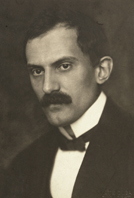Babits Mihály: The tomb of Hegeso (Hegeso sírja in English)
Hegeso sírja (Hungarian)Egy görög emlékre
A kedvesem kétezer éve alszik, kétezer éve meghalt s vár reám. A neve Hegeso. - Lábhegytől arcig márványszinű - s komoly görög leány.
Élő, habár lehellete se hallszik keble átduzzad ráncos khítonán Fürtös fejében ki tudja mi rajzik? Ül meghajolva. Méla. Halovány.
Előtte állva szolgálója tartja rabszolgalány, a drága ládikát, amelyből ékszereit válogatja.
Talán azt nézi (lelkem bús reménye!) melyikkel ékesítse föl magát, ha megjövök majd én, a vőlegénye.
1908
|
The tomb of Hegeso (English)On a Greek monument*
My heart’s true bride has slept two thousand years; Dead for two thousand years, she waits for me. A Greek girl, Hegeso, sedate to see from head to foot pale marble she appears.
Living, I swear, though none her breathing hears, Her robe, conceals a heart’s grave systole, Thoughts in that curly head flow full and free As bowed she sits, pale, pensive, and sincere.
Before her stands a slave, a little girl, Who holds a costly casket, from whose freight She sets out gems, rare amethyst and pearl;
Perchance (I dream) she means in jewelled state Her treasured virgin beauty to unfurl When I, hereafter, come to be her mate.
*A marble grave-stone in the National Museum, Athens. Dating from about 425 B.C., the relief carving shows Hegeso seated in a chair, sorting out jewels from a casket held by a slavegirl.
|
||||||||||





